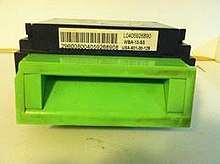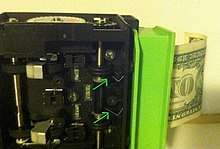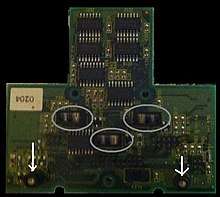Currency detector
A currency detector or currency validator is a device that determines whether notes or coins are genuine or counterfeit. These devices are used in a wide range of automated machines, such as retail kiosks, supermarket self checkout machines, arcade gaming machines, payphones, launderette washing machines, car park ticket machines, automatic fare collection machines, public transport ticket machines, and vending machines.
The process involves examining the coins and/or notes that have been inserted into the machine, and conducts various tests to determine if the currency is counterfeit. Because the parameters are different for each coin or note, these currency acceptors must be correctly programmed for each item to be accepted.
In normal operation, if any item such as a coin, banknote, card or ticket is accepted, it is retained within the machine and it falls into a storage container to allow a member of staff to collect it later when emptying the machine. If the item is rejected, the machine returns the item to the customer. If a coin is rejected, it usually falls into a tray or rolls out of a slot at the bottom where the customer can remove the coin. If a banknote, card or ticket is rejected, it is ejected out of the machine so that the customer can remove it from the slot into which it was inserted.
Coin acceptors
The basic principle for coin detection is to test the physical properties of the coin against known characteristics of acceptable coins. The coin acceptor identifies the coin according to its mass, size, diameter, thickness, metal composition and/or magnetism, and then sends an appropriate electrical signal via its output connection. The next step is generally performed by the banknote-to-coins exchanger.
Today, sophisticated electronic coin acceptors are being used in some places that, in addition to examining the mass, weight and size, also scan the inserted coin using optical laser beams and match the image to a pre-defined list, or test the coin's "metallic signature" based on its metallic composition.
Normal circulation coins eventually collect microscopic particles of dirt, dust, oil and grease from people's fingers. When a coin acceptor is used for a long time, thousands of coins rolling along a track will leave enough dirt, dust, oil and grease to be visible. As a consequence of this, the coin acceptor must be cleaned properly on a regular basis to prevent malfunction or damage. Coin acceptors are modular, so a dirty acceptor can be replaced with a clean unit, minimising downtime. The old unit is then cleaned and refurbished.
Some new types of coin acceptors are able to recognize the coins through "training", so they will support any new types of coins or tokens when correctly introduced.
Testing methods
Vending and change machines use several methods of deciding whether a banknote is genuine. Adjusting these settings and the sensitivity of each is programmed via means of DIP switches on the internal circuitry.
Optical sensing
Optical sensing with a small light detector called a photocell or a miniature digital camera is one of the main techniques that vending machines use. Many countries' banknotes are pixelated—that is, they are made out of small dots. The dots are spaced differently and have different sizes, depending on the note. The optical sensors can look for these different patterns to determine what sort of note has been inserted. Some paper money is also fluorescent: it glows when ultraviolet light is shined on it. Some machines shine an ultraviolet light on the note and measure the glow to help determine the banknote's material composition.
GMR sensor proximity detection
The particles in the ink on many countries' currency have ferromagnetic properties, including some elemental iron.[1] Magnetic composition comprises carbon nanofoam in an amount of from 0.1 to 45 percent by weight of the total composition.[2]
Notes are passed over a permanent magnet array and magnetized along their direction of travel. A magnetic sensor located several inches away with its sensitive axis parallel to the direction of travel can detect the remnant field of the ink particles.
The purpose of the biasing magnet in this case is to achieve a controlled orientation of the magnetic moments of the ink particles, resulting in a maximum and recognizable magnetic signature. Reversing the magnetizing field can actually invert the signature.[3]
Physical attributes
The thickness and dimensions of a banknote are tested to ensure they are correct. US currency is 2.61 inches wide by 6.14 inches in length and are 0.0042 inches thick, and weigh 1 gram.[4] Currency printed prior to 10 July 1929 had larger physical characteristics.[5] As the notes pass between the rollers, the voltages vary according to their thickness.[6]
Miniature transducers, approximately 3/8" diameter, offer high accuracy linear measurement in a compact space where size constraints prohibit the use of standard LVDTI's. In addition, the low- mass core is ideal for systems with low driving forces or high acceleration and, therefore, will not adversely influence the delicate nature of these applications. Operating ranges are available from ±0.005" to ±1.00", divided into eight intermediate strokes.[6]
Genuine Federal Reserve notes have a clear polyester thread embedded vertically in the paper. The thread is inscribed with the denomination of the note, and is visible only when held up to light. Each denomination has a unique thread position and will glow a unique color in ultraviolet (UV) light.[7]
Banknote acceptors

Also known as validators or acceptors, paper currency detectors scan paper currency using optical and magnetic sensors. Upon validation, the validator will inform the vending machine controller (VMC) or other host device of a credit via a parallel or serial interface. Various interfaces exist for the host device, including a single-line pulse interface, a multi-line parallel interface, a multi-line binary interface, and serial interfaces such as ccTalk, SSP, and MDB. Wrinkled or creased notes can cause these machines to reject them.


There are currently only a handful of companies manufacturing this equipment. Crane Payment Innovations (joining Crane Payment Solutions and MEI), and Japan Cash Machine (JCM) are two of the largest, each maintaining dominance in a particular market segment. Other notable companies producing this type of equipment include Coinco, Pyramid Technologies, Inc. (PTI), International Currency Technologies (ICT), Alpha CMS (Cash Management Solutions), Astrosys, Pyramid Technologies, Validation Technologies International (VTI), Innovative Technology Ltd (ITL), Global Payment Technologies (GPT) and Jofemar. Recent innovations include remote auditing and reporting by these devices as part of an Automated Cash Handling network for entertainment, banking, retail, casino and other industries.
See also
References
- "MONEY IN A BLENDER-A MONEY SMOOTHIE". Steve Spangler Science. 2013. Retrieved 26 May 2014.
- Xerox Corporation (Apr 26, 2006). "Magnetic ink composition, magnetic ink character recognition process, and magnetically readable structures" (EUROPEAN PATENT SPECIFICATION). EP 2 390 292 B1. European Patent Office.
- Caruso, Michael J.; C.H. Smith; T. Bratland; R. Schneider. "A New Perspective on Magnetic Field Sensing" (PDF). Plymouth, MN and Eden Prairie, MN: Honeywell SSEC and Nonvolatile Electronics: 14–15. Cite journal requires
|journal=(help) - "US Currency FAQs". US Bureau of Engraving and Printing. 14 May 2014. Archived from the original (FAQ) on 5 May 2015. Retrieved 26 May 2014.
The approximate weight of a note, regardless of denomination is (1) one gram.
- "Six Kinds of United States Paper Currency". Retrieved 26 May 2014.
- "LVDT use in ATM to Sense Dollar Bills" (PDF). LVDT Application. Trans-Tek, Inc.: 1. Archived from the original (PDF) on 30 May 2013. Retrieved 26 May 2014.
- "Know Your Money" (PDF). US Secret Service. April 2008. Archived from the original (PDF) on 8 February 2015. Retrieved 26 May 2014.